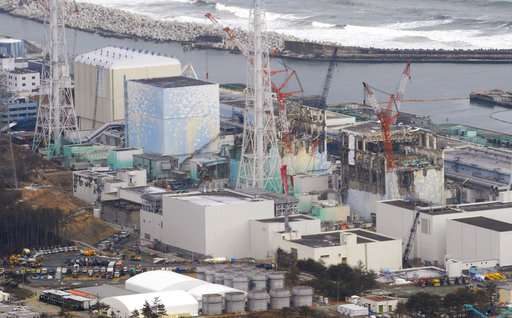In this March 11, 2012, file photo, three melted reactors, from left, Unit 1, Unit 2 and Unit 3, are seen at Fukushima Dai-ichi nuclear power plant in Okuma, Fukushima prefecture, Japan. Japan's government approved on Tuesday, Sept. 26, 2017 a revision to the decommissioning plan for the Fukushima nuclear plant, delaying by two more years the removal of radioactive fuel rods in two of the three reactors damaged in the 2011 disaster. It still plans for melted fuel to be removed starting in 2021, but the lack of details about the duration raises doubts if the cleanup can be completed within 40 years. (Kyodo News via AP, File)
Japan's government on Tuesday approved a revision of its 30-to-40-year plan to decommission the Fukushima nuclear plant, delaying by three more years the removal of radioactive fuel rods stored at two of the three reactors damaged in the 2011 disaster.
Six and a half years since a massive earthquake and tsunami struck the plant on Japan's northeastern coast, the amount of contaminated water that must be pumped out and treated every day has decreased significantly, and remote-controlled robots have provided a limited view of melted fuel debris inside the reactors. Still, the exact location of the melted fuel is largely unknown and robots that can withstand the high radiation for prolonged work there are still being developed.
Among the highest risks at the plant are 1,573 fuel rod units, each consisting of dozens of fuel rods, which are cooled with water in storage pools that are not enclosed within the reactor buildings. The plant operator, Tokyo Electric Power Co., had planned to start moving them to safer storage by the end of fiscal 2020, but the latest plan says three more years are needed for reactor Units 1 and 2. Including delays made in earlier revisions, the fuel rod removal plan is now up to six years behind schedule. Removal at the Unit 3 reactor is set to start next year and is expected to take about two years to finish.
Naohiro Masuda, TEPCO's Fukushima Dai-ichi plant decommissioning chief, said the delay results from previously unknown damage in the storage pool areas and the need for more radioactive decontamination.
He acknowledged that the 30-40-year cleanup plan "may not sound convincing because of all the unknowns and we haven't found most of the melted fuel" inside the reactor cores. But he said it's important to set a target for developing the technology and work toward that goal.
The decommissioning plan, the second revision approved since the disaster, still calls for the removal of the melted nuclear fuel inside the reactors to start in 2021, based on recent findings on more efficient methods.
But the plan still lacks details regarding the duration of the melted fuel removal, how the radioactive waste will ultimately be stored and the final status of the plant itself, raising doubts about whether the cleanup can really be completed in 40 years.
Removing the reactors' melted fuel is by far the hardest part of the decommissioning. An underwater robot in July saw large amounts of rock-like objects and solid lumps, apparently melted nuclear fuel mixed with melted and mangled equipment and internal structures, on the floor of the Unit 3 primary containment chamber. The search for melted fuel in Units 1 and 2 has been unsuccessful due to structural damage and extremely high radiation. Despite the unknowns, debris removal methods will be finalized in 2019 and the actual removal is set to start at one of the reactors in 2021 as planned.
Japan still has no plan for the waste that comes out of the plant during decommissioning. The government and TEPCO are to compile a basic plan during fiscal 2018 when the melted debris removal begins.
© 2017 The Associated Press. All rights reserved.























